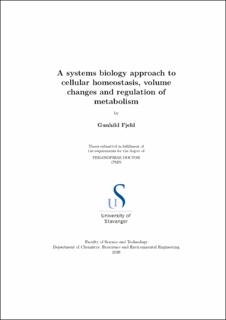| dc.contributor.advisor | Thorsen, Kristian | |
| dc.contributor.author | Fjeld, Gunhild | |
| dc.date.accessioned | 2020-04-22T08:23:16Z | |
| dc.date.available | 2020-04-22T08:23:16Z | |
| dc.date.issued | 2020-04 | |
| dc.identifier.citation | A systems biology approach to cellular homeostasis, volume changes and regulation of metabolism by Gunhild Fjeld, Stavanger : University of Stavanger, 2020 (PhD thesis UiS, no. 509) | en_US |
| dc.identifier.isbn | 978-82-7644-916-7 | |
| dc.identifier.issn | 1890-1387 | |
| dc.identifier.uri | https://hdl.handle.net/11250/2652005 | |
| dc.description.abstract | Cells need to respond to a vast range of different disturbances and changes over small and large time scales. This can be disturbances in the form of molecules used to fight infectious states, changes in growth patterns, disturbances in the external environment, or even just normal maintenance processes that require compensatory actions. Throughout all of these processes, the cell always needs to maintain its inner environment relatively constant. This phenomenon is called homeostasis and happens through interactions between genes, proteins and metabolites that form complex regulatory networks.
The regulatory function of these networks is achieved through a combination of control mechanisms, such as negative feedback, feedforward, integral control and proportional control, although often in a bit disguised form as the networks typically contains imperfections such as leakage, saturation and other nonlinearities. This thesis is a systems biology approach, inspired by concepts from control engineering and control theory, to examine properties and functions of regulatory networks.
The first part of this thesis aims to explore how regulatory networks in the form of two-component negative feedback controller motifs respond to various types of disturbances or perturbations. The controller motifs have been introduced in previous work and have a structure that combines negative feedback and integral control, consequently giving them homeostatic functions. However, as we show in this work, their ability to compensate for time-dependent perturbations that increase linearly, exponentially, and hyperbolically, is different dependent the kinetics of the reactions in the motif.
The second and third parts of this thesis is a study of cancer metabolism, with emphasis on how cancer cells can regulate and maintain a high sustained glucose uptake during growth. Cell growth cause dilution effects and is an example of a perturbation that increase over time. The coupling between glucose metabolism and glutamine metabolism is also explored, and how this may be linked to growth and advantages for cancer cells.
This last part is done through experimental measurements of metabolic fluxes using a Seahorse XFp analyzer. Inhibitors of key enzymes are used sequentially in customized protocols through the experiments and enables the isolation of individual pathways and the evaluation of these fluxes. The use of the two new inhibitors is novel and so is the comparison between three pathways originating from glutamine. | en_US |
| dc.language.iso | eng | en_US |
| dc.publisher | Stavanger: University of Stavanger | en_US |
| dc.relation.ispartofseries | PhD thesis UiS;509 | |
| dc.relation.haspart | Paper 1: Fjeld, G., Thorsen, K., Drengstig, T & Ruoff, P. (2017) The Performance of Homeostatic Controller Motifs Dealing with Perturbations of Rapid Growth and Depletion. Journal of Physical Chemistry B, 121(25), pp. 6097-6107 (Not in Brage) | en_US |
| dc.relation.haspart | Paper 2: Fjeld, G., Thorsen, K., Drengstig, T & Ruoff, P. (2020) Exploring Mechanisms of Glucose Uptake Regulation and Dilution Resistance in Growing Cancer Cells. Submitted to Biophysical Journal | en_US |
| dc.relation.haspart | Paper 3: Fjeld, G., Nordgaard, O., Thorsen, K. (2020) Using UK5099 and galloflavin to examine glutamine metabolism through sequential inhibition in a real time setting. Submitted to Cancer and Metabolism. | en_US |
| dc.subject | kreft | en_US |
| dc.subject | cancer | en_US |
| dc.subject | biologisk kjemi | en_US |
| dc.title | A systems biology approach to cellular homeostasis, volume changes and regulation of metabolism | en_US |
| dc.type | Doctoral thesis | en_US |
| dc.rights.holder | © Gunhild Fjeld, 2020 | en_US |
| dc.subject.nsi | VDP::Medisinske Fag: 700::Klinisk medisinske fag: 750::Onkologi: 762 | en_US |
| dc.subject.nsi | VDP::Matematikk og Naturvitenskap: 400::Basale biofag: 470 | en_US |
